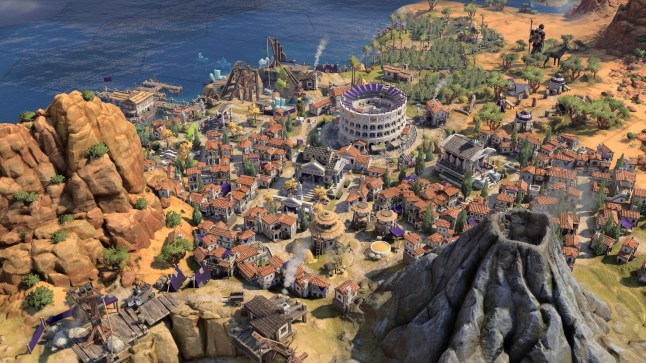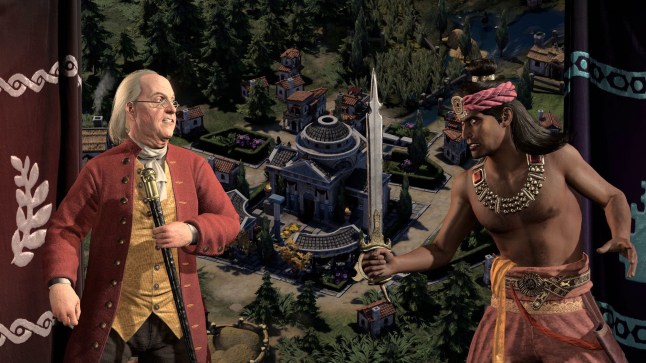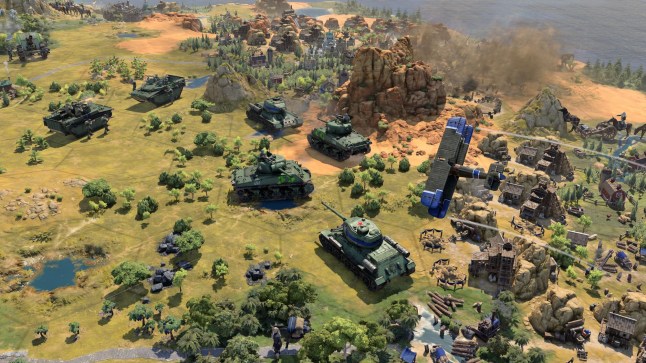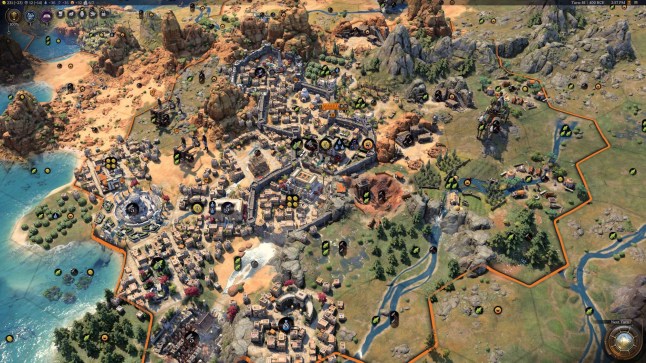
GameCentral gets to play the first new Civilization game in almost a decade and learns why there are no more barbarians but lots more exploration.
Of all the hundreds of video games being shown at Gamescom last week, Civilization 7 must surely be the least well suited to being demonstrated in a noisy room where you’ve only got 30 minutes to play it. But Civilization 7 is a big deal and publisher 2K went to a lot of effort to make sure everyone knew it.
In actual fact, we only got 15 minutes on the game, because we broke off early in order to talk to creative director Ed Beach, but that’s fine. We’ve been playing Civilization games for over three decades now and we know the basics very well.
Nevertheless, it’s been eight years since Civilization 6 and developer Firaxis has been making some bold claims about this new sequel. They’ve attempted to redesign the game from the ground up, making major structural changes to how it works and how it rewards progress. And from what we can tell it’s all looking very positive.
Given a full game of Civilization takes several hours to play through, whether the hands-on was 15 minutes or 30 didn’t make any difference. However, we did get to see the new interface and visuals, which seem to be a mild improvement on the previous game.
We also sat through a 30 minute presentation from Firaxis and that was far more illuminating. At its heart the game is the same as every Civilization before it: an epic scale strategy game where you take your chosen people from prehistory to the modern day and beyond, slowly exploring the world and attempting to dominate it via war or cultural influence.
Although the modern games try their best, it’s almost impossible to make Civilization look visually interesting but playing them is utterly engrossing, given the level of control you have and the surprisingly accessible controls.
The big new idea for Civilization 7 is that each game is split into three ages: antiquity, exploration, and modern eras. This creates a much more structured experience than before, with the new ability to switch the civilisation your society is based on at the start of each new age, as well as the leader.
We discussed the ramifications of this in detail with Beach, but it’s both to increase the realism of the game and to compensate for the fact that exploration is always the best bit. Each age will end in a specific crisis, to set the agenda for the next age and to ensure your interest doesn’t waver – which is something that tends to happen with the older games, as you get bogged down in administrative details.
There are other big changes too, such as commanders which take all the experience of military units under them and allow armies to manoeuvre as a single entity, but the biggest is the overriding idea that ‘history is built in layers’, which permeates many of the new features and sets the tone for the entire sequel…
GC: Well, that demo worked. Because now I want to play more Civilization.
EB: [laughs]
GC: So, just to make sure I understand: there’s now three ages and you can change civilisations between them? So maybe from Egypt to England to America.
EB: Well, you couldn’t go Egypt to England.
GC: Oh, so they have to be related?
EB: It has to be a civilisation that historically was prominent during the Middle Ages and Renaissance. So you could do Egypt to the Normans to Britian, for instance. England’s sort of a weird construct. We’ve always had it in the game, but it always was awkwardly placed, because you’d be there, and you’d be England in 4,000 BC… next to Egypt and Babylon.
GC: So I guess that’s the whole idea behind ages, trying to make it seem more realistic?
EB: I find it more realistic. I’m an amateur historian and I love to learn about things. The presentation we gave there talked about how our design team studied London and how we looked at how London evolved from a Roman city to an Anglo-Saxon/Norman city to a Victorian City… So, to me it is more realistic.
There are some things that are also still just as wacky as Civilization’s ever been. Because we’re allowing players to, if they want to, swap in leaders and assign different leaders to civilisations that might have occurred historically. Some players are gonna go and still have non-historical set-ups, but for those players that really like the historical immersion I think this is the better set-up.

GC: So you could have an Egyptian civilisation but led by someone from a different continent?
EB: Yes. When you set up the game, and I think you probably saw this in the demo, there’s something that says ‘historical choice’. And so most of the civilisations have a leader that just makes sense to go with them.
We’ve tested this with a lot of focus groups and so forth and without that kind of grounding players were immediately going for wacky combinations. Whereas the players that want their games to be a little bit more of a history simulator want to have the knowledge of how to set things up right. But we have other players who just want to be as powerful as they possibly can be, and they just want to make useful combinations.
GC: So this raises the age old video game question of realism vs. gameplay. You said there were no barbarians anymore, is that just because the term has become unfashionable?
EB: The term we got rid of, because it is…
GC: But barbarians were a cool thing to come across in the game and now they seem to have been turned into static cities?
EB: We have independent powers now and they’ll still attack you. They still work in a very similar way. Now, depending on how your game is randomised at the beginning it might be that the nearby tribe is friendly or it might that there’s two hostile tribes nearby and you have to react to that right away. Just like in previous games, you’re not sure how much of a threat they’re gonna be, but they are very much something you’re going to have to deal with at some point or another.
GC: Is the whole question of realism vs. gameplay at the top of your whiteboard? Is that your biggest struggle?
EB: It is! It is. We have almost doubled down on the stakes with that, because we’ve hired PhD historians – we have one with a speciality in South East Asia, one with a speciality in Viking history – and they’re both on our staff. But they’re players too.
So they’re helping us straddle the line between depicting these cultures in a sensitive way and drawing out some of the very interesting stories about these leaders and these cultures, that makes sense in a Civ universe. But at the same time, they realise that we are still just a game and it’s somewhat of a weird historical sandbox where you mash up different elements.
GC: The thing about invading other countries, is it’s all good fun when it’s France…
EB: [laugh]
GC: …but the more realistic you make it the more you encroach on difficult territory, even if that does give you some insight into how people would’ve thought of the process at the time.
EB: Yeah. Take the Spanish conquistadores, those guys were glorified during the day but when we look at them now it’s very, very different. And I’ve people on the team saying, ‘I have something like that I need to portray in the game, how do I write that into my narrative? How do we talk about that?’
We are giving players motivation to still go to distant shores and set up a huge empire across the world, just like Spain did. But we are a little more nuanced in our presentation. We might have a little story that pops up, that tells you about what’s happening to the people that live there.
So, we’re giving the player just a little bit of a nod to, ‘Hey! Knock, knock, knock! Think about this.’ This may be a ton of fun right now but maybe longer term you’ll reflect on it and realise there are a few consequences.
GC: Are there any consequences in gameplay terms?
EB: Cities that you conquer are going to be less loyal to you, they’re going to be less happy. At the end of each of the ages, something new that we’ve put in is a crisis system, where we’re modelling how empires fell apart.
Like, how did Rome fall? It was partially because of the barbarians, partially because they were corrupt internally and civil wars were breaking out, and partially they had plagues and other things infesting them. And so, what happens is at the end of the age your empire’s gonna start to crack at the seams a little bit.
So that’s an interesting reflection of the cycle of history that we haven’t had in the game before, and it gives players a new challenge and a sort of narrative explanation as to why their empire’s not perfect.

GC: As much as I’ve always enjoyed it there is an inherent unevenness about Civilization. The first half of the game is always much more entertaining than the second, even if the second is still good. I don’t think that’s an unusual point of view.
EB: You are not alone! [laughs] This version is directly engaging with that. The more sophisticated the games are, the more data we get about how people are playing them and the numbers that I was getting back as to how many people started a game of Civilization 6 and actually ever finished it one time…
GC: And yet I bet they weren’t unhappy with their experience.
EB: Yeah, yeah! But we’re developing a lot of content about what modern times are like, and what they should look like, and if the players are always ending the game before they get to that, what are we doing? So what the ages system does is it gives players chapters so there’s something drawing them forward. It’s not impossibly far in the distance.
And when they hit the end of that structure, they hit the crisis, they survive, but they have to sort of regroup and get ready for that next cycle of history. And we can simplify the game again. So, you’re talking about the exploration is the best part of the game and we 100% agree with that.
One of our problems was that exploration lasted about 50 or 70 turns, something like that, and occasionally you would get it later, when you cross the ocean, but with some of our maps the whole map was just one big continent and you didn’t even have the other side of the world to explore.
Now we are setting up the game so there’s always a second half of the world. No matter what your first land mass looks like, there’s always an ocean separating you from the other half. And so when you go into the age of exploration… it’d be horrible for us to name it the age of exploration and the exploration’s all done, right?
We enforce that there’s gonna be exploration there, because the other half of the map you’ve not encountered at all. And so you get that good feeling, basically that feeling of that first 50 turns – we want to give you that as many times as we can. And so we’ve enforced that in the way the map unfolds.
GC: Religion has been a part of the last few games, but I don’t think you mentioned it in the presentation. It’s another difficult subject because it’s so important to history and yet it’s clearly a thorny issue.
EB: It’s interesting. I was the one that… it was in Civ 4 but in a very, very abstract way. And I was the one who was designing how to put it into Civ 5 and I followed that up into 6. And I wanted it to be more embedded in the game, more an essential part of the game.
So we introduced faith as a resource that you collect… so, religion still plays a key role in this game but mostly in that exploration age phase. In the beginning of the game you can still establish a pantheon, you can have some gods you worship. There’s like a processor to the major organised religions.
Those all come in, in the next age and just like the wars of religion that came into being during the Reformation, or the Crusades, that’s represented in that medieval and Renaissance period of history. We couldn’t have that period represented properly without that.
So religions will all start there, they’ll be competing for the hearts and minds of the people, just like before, but we do have it start to peter out, and have a less prominent role, later. So we got rid of the faith resource, you wouldn’t see that on the map here. We have a more generic resource called happiness and that’s what’s a reflection of what religion’s providing for you.
GC: It’s interesting that religion is still a layer of history everywhere you look, even if it’s just something like rivalries between football teams. That sense that a particular religion has always been at the centre point of a city or civilisation.
EB: We’re not giving out too many details about the modern part of the game, but you have actually hit on something that… We playtested religion only being in the exploration age and not having vestiges and echoes of it afterwards felt wrong. And we have added that back in since, the heavy competition in wars over religion is just in that middle part of the game, but the echoes can persist.
GC: That’s very interesting. And just briefly, have you said anything about consoles? I’m not sure if I’ve missed a memo about them.
EB: Civ 6 is going to all the major platforms. PlayStation, Xbox, and Nintendo Switch…
GC: Oh, I did miss that. You’ve got the game running on Switch?!
More Trending
EB: Yes. It looks a little visually different, but the gameplay is identical. We’re shipping to all those platforms, we don’t want to leave anyone behind.
GC: Well, that’s great. That all sounds very promising. Thank you for your time.
EB: Thank you, good questions.
Formats: PC (previewed), Xbox One, PlayStation 4, Nintendo Switch, Xbox Series X/S, and PlayStation 5
Price: £59.99
Publisher: 2K
Developer: Firaxis Games
Release Date: 11th February 2025
Age Rating: 12

Email gamecentral@metro.co.uk, leave a comment below, follow us on Twitter, and sign-up to our newsletter.
To submit Inbox letters and Reader’s Features more easily, without the need to send an email, just use our Submit Stuff page here.
For more stories like this, check our Gaming page.
MORE: OG Warzone map returns to Call Of Duty next year and fans can’t wait
MORE: PS5 Pro console design leaks – official reveal coming ‘very soon’
MORE: Emio – The Smiling Man: Famicom Detective Club – horrifying Nintendo sequel













